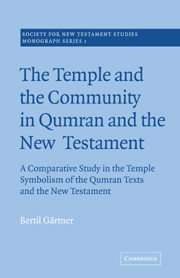 The Temple and the Community in Qumran and the New Testament
The Temple and the Community in Qumran and the New Testament Book contents
- Frontmatter
- Contents
- List of Abbreviations
- Introduction
- AUTHOR'S NOTE
- I The Priesthood and the Jerusalem Temple
- II The Temple Priests and Qumran
- III The ‘New Temple’ in Qumran
- IV Temple Symbolism in the New Testament
- V Temple Symbolism and Christology, Collective and Individual
- Bibliography
- Index of Authors
- Index of Subjects
- Index of Passages Quoted
III - The ‘New Temple’ in Qumran
Published online by Cambridge University Press: 26 February 2010
- Frontmatter
- Contents
- List of Abbreviations
- Introduction
- AUTHOR'S NOTE
- I The Priesthood and the Jerusalem Temple
- II The Temple Priests and Qumran
- III The ‘New Temple’ in Qumran
- IV Temple Symbolism in the New Testament
- V Temple Symbolism and Christology, Collective and Individual
- Bibliography
- Index of Authors
- Index of Subjects
- Index of Passages Quoted
Summary
ONE of the fundamental elements in the temple symbolism of the Qumran community was a conviction that the ‘presence’ of God, the Spirit of God, was no longer bound to the temple in Jerusalem but to the true and pure Israel represented by the community. The Jerusalem temple had been defiled by ‘the wicked priest’ and his people. The fathers of the community therefore left ‘the holy city and placed their trust in God in those days when Israel sinned and made the temple unclean’ (C.D. xx. 22f.). But the fact of the disruption did not mean that it was impossible to replace in some way the Divine presence and the cultus of the temple. Thus it was that the community came to replace the temple of Jerusalem; they themselves were the ‘new temple’. This symbolism was of course not wholly due to the fact that they traced their descent to the company of the temple priests and that certain of their number were priests; we must reckon with the belief, common among the Jews at that time, that the temple would be restored and re-established in the last days. The old temple would be replaced by a new one, of quite new dimensions.
As far back as the traditions of Ezekiel and Haggai we find the idea of the coming aeon, under the rule of God, when a new temple would be given to the people to replace the one which had been destroyed.
- Type
- Chapter
- Information
- The Temple and the Community in Qumran and the New TestamentA Comparative Study in the Temple Symbolism of the Qumran Texts and the New Testament, pp. 16 - 46Publisher: Cambridge University PressPrint publication year: 1965
- 1
- Cited by


